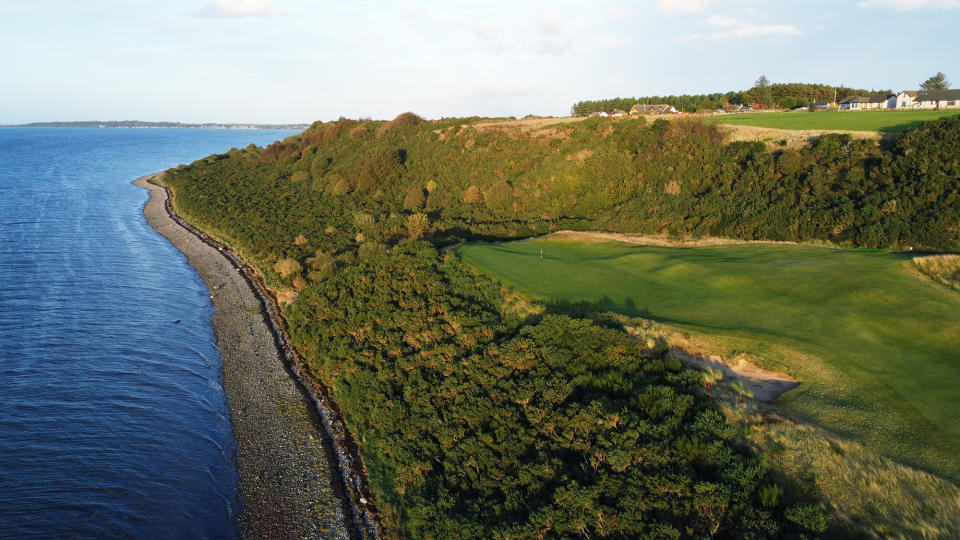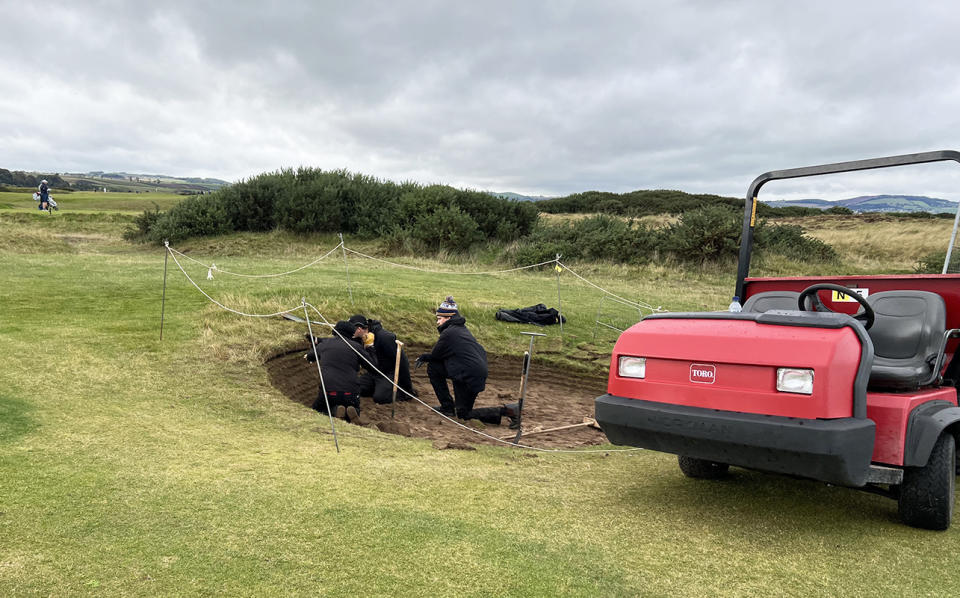Q&A: Architect Tom Doak talks about his new course at Cabot Highlands in Scotland, modern design and more
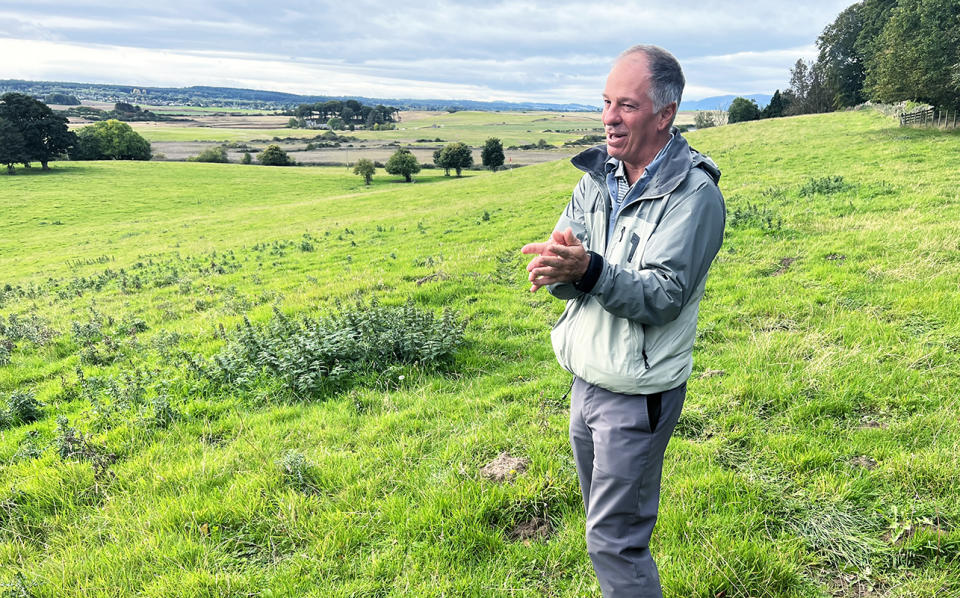
What do you get when you hand over some 150 acres of prime waterfront land in the Scottish Highlands to American golf architect Tom Doak? Not even Doak is sure yet.
But Cabot – the rapidly expanding Canadian company that started with the highly acclaimed Cabot Links and Cabot Cliffs in Nova Scotia – is betting Doak’s work will be worth an overseas flight for traveling golfers.
Cabot acquired Castle Stuart Golf Links and its eponymous 18-hole layout near Inverness, Scotland, in June with development plans that include a second course and luxury cabins just minutes away from the Inverness airport. The property has been rebranded Cabot Highlands. Ben Cowan-Dewar, CEO and co-founder of Cabot, has hired Doak to build the second 18 with plans to break ground in 2023 and a possible soft opening sometime in 2024.
Book your round at Cabot Highlands today
“We’ve got to get the routing done first,” quipped Doak with a laugh as he met with a small group of American and Canadian golf writers in October at Castle Stuart.
Cabot has expanded rapidly in recent years. The company took off in 2012 in Nova Scotia with Cabot Links, a Rod Whitman design that ranks No. 2 on Golfweek’s Best list of modern Canadian courses. That course was joined in 2015 by Cabot Cliffs, a Bill Coore and Ben Crenshaw design that ranks No. 1 on that modern Canadian list.
In the Caribbean, a Coore and Crenshaw design at Cabot St. Lucia is slated to open in 2023. In Canada, the company announced last year the development of Cabot Revelstoke in British Columbia, which will feature a Whitman design scheduled to open in 2024. And in Florida, Cabot has purchased the former World Woods, rebranded it Citrus Farms and is having its two courses renovated with a planned reopening in 2023.
The second course at Cabot Highlands will mark the first time Doak has worked with Cowan-Dewar, but Doak has established himself as one of the premium designers of his era. His course credits, either solo or in combination with other designers, include 12 courses on Golfweek’s Best list of the top 200 modern courses built since 1960 in the U.S., including four in the top 10. He also laid out five of the top 50 Golfweek’s Best modern international courses, including three of the top five on that list.
Gil Hanse and Mark Parsinen designed the original 18 at Castle Stuart in Scotland, now named Cabot Highlands. (Golfweek)
Doak met the handful of writers, including this author, at Cabot Highlands’ clubhouse, then led the group on a tour of some of the property where the new course will be constructed. It’s a stunning site alongside the Moray Firth, a huge bay that is fed from a river that flows through nearby Inverness with waters from Loch Ness.
The original 18 at Cabot Highlands, built by Gil Hanse and Castle Stuart founder Mark Parsinen (who died in 2019), sits high upon cliffs overlooking the Moray Firth with some of the most dramatic golf views in Scotland. That course opened in 2009 and ranks No. 4 on Golfweek’s Best list of modern courses in Great Britain and Ireland. It has hosted the Scottish Open four times.
Doak’s parcel is lower, stretching from the clubhouse, past a 400-year-old castle that gave the property its original name and down a ridge toward the water. The rolling site has been farmed with the land smoothed over as it descends toward the coast, which means Doak’s team likely will move a lot of earth to create interesting internal contours – similar to the original layout at Castle Stuart.
Doak said the new course won’t quite be a true out-and-back routing with nine holes in one direction and nine coming back, but it likely will be close to that with a few redirections along the way. Parsinen originally planned to build a course by Arnold Palmer on the site, but those plans have been replaced.
Doak spoke candidly about the opportunities, challenges and thrill of building on the site and in Scotland in general. He also spoke openly about several of his other projects around the world and how he approaches the lofty expectations that come with building on such a beautiful site. Lengthy excerpts of that conversation are included below.
Question: What were your initial thoughts on the new course here?
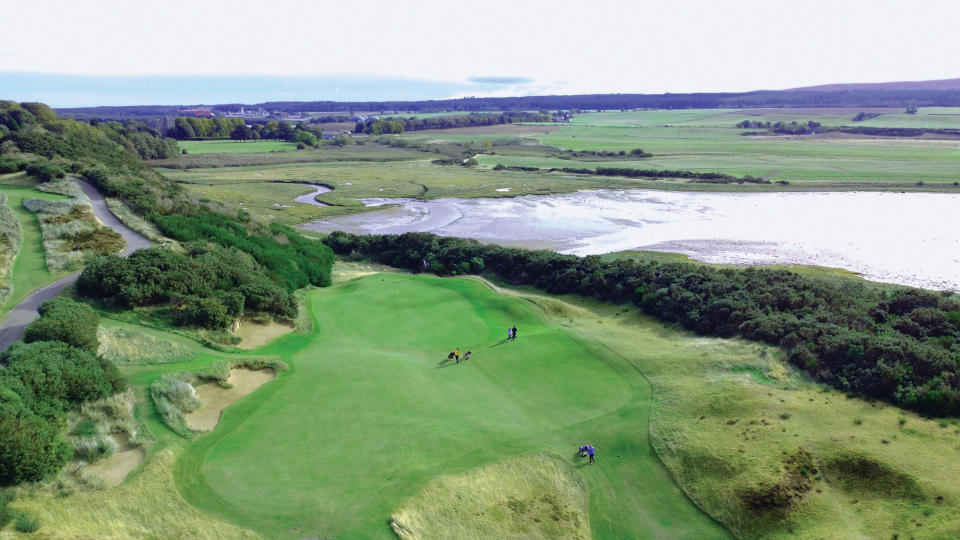
Much of the site for Tom Doak’s planned golf course lies beyond the first 18 holes at Castle Stuart, now named Cabot Highlands in Scotland. (Golfweek)
Tom Doak: We have some holes along the water, and we’ve got some pretty good elevation where you feel like the couple holes at Royal Dornoch that are up overlooking the rest of it. But there are some awkward spaces that are kind of too wide for one hole and not wide enough for two holes – what do we with that (said with a laugh)?
It’s been tricky to try to make it all fit together. We’re not happy with the routing until every hole is something we really like. There are a couple that we’ve been fighting with, like, “What are we going to do to make that hole fit the rest?”
There are a lot of beautiful things to aim at, like this golf course (the original Castle Stuart) has, but there are also one or two things we’re trying not to see. That’s tricky sometimes because it’s so open.
How many times does it take you to see a site to come up with a routing?
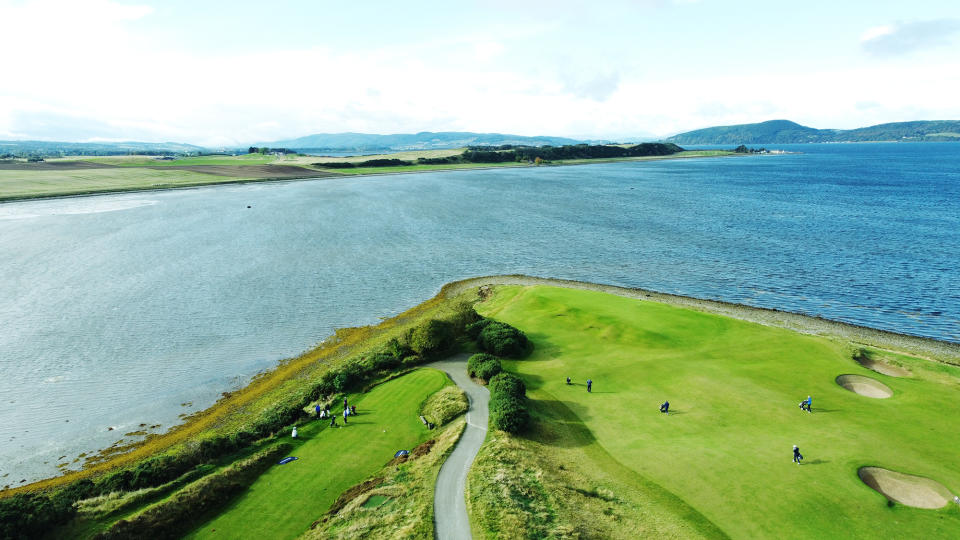
Much of the site for Tom Doak’s planned golf course can be seen in the distance across a small cut of water from the first 18 holes at Castle Stuart, now named Cabot Highlands in Scotland. (Golfweek)
It depends on the site and if I’m having a good day. You know, I’ve done 40 golf courses, which means I’ve probably routed double that over my lifetime. A couple times I’ve hit the routing before I ever really got on the site, just working on the maps. If it’s all about topography, that I can visualize on the map. But it’s not all about topography. You know, “I want this hole to aim at that mountain in the distance” instead of halfway in between that mountain and the bridge.
So on sites where you have views, or on sites where you have a big beautiful tree or whatever, that affects what you’re going to do. And you’re never going to visualize that from the map. So there’s a back and forth usually. The more complicated it is, and the more land you have to choose from, the more time it takes to sort out that, “This is the best I can do with it.”
One of the hard parts about this (site) is there is a lot of land out there to potentially use. Your natural instinct is to use all the land closest to the shore first, but that’s not necessarily where the best views are.
What’s the latest that you’ve ever changed a hole in the routing during a build? How far along can you get?
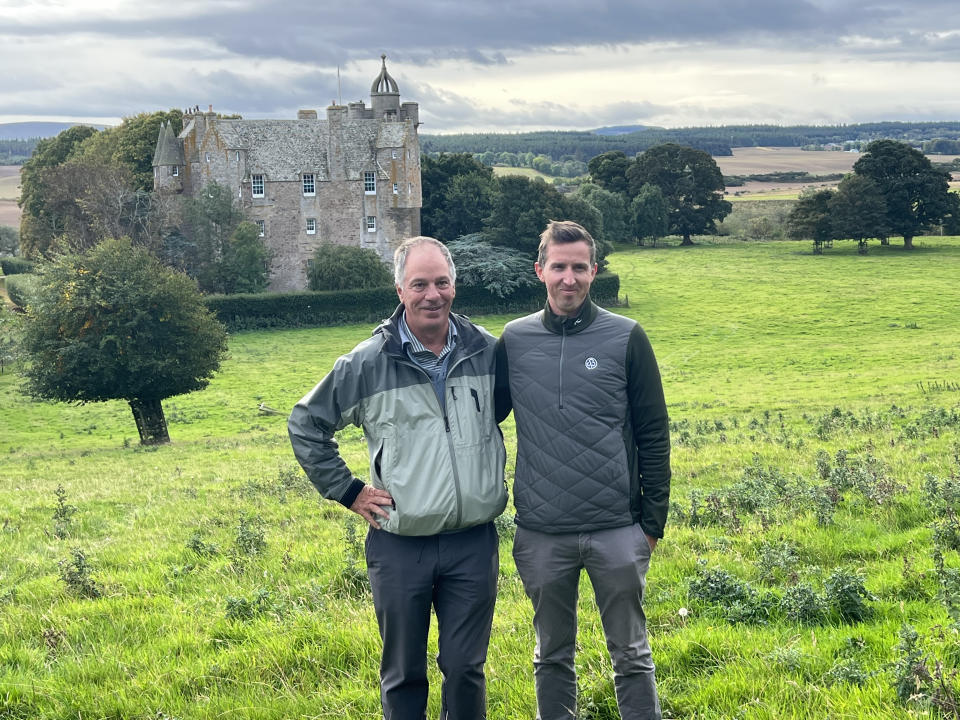
Tom Doak with Clyde Johnson at the site of a new course and 400-year-old namesake castle at Castle Stuart/Cabot Highlands near Inverness, Scotland. (Jason Lusk/Golfweek)
When there’s three holes left (with a laugh), with a bunch of holes grassed already. Stonewall (in Pennsylvania) was like that. …
When you start, there’s always two or three holes where you’ve got an idea that you can make it work but you don’t know exactly what you’re going to do to make it really good. And you never really know the style of the clients, because they don’t know what all to ask. They ask a lot about the scorecard, they ask a lot about “What style of bunkering are you going to use here?” Usually, I’m five or six holes in before I can tell you that because we’re experimenting.
We’ll try something and see how that looks, then let’s try something a little different over here. But once we get three or four holes that we feel like are done, then we work out what that is and we just run with that.
You’re not the type of guy who’s stuck on par 72 or anything like that. You would do a par-69 course in a minute, would you not?
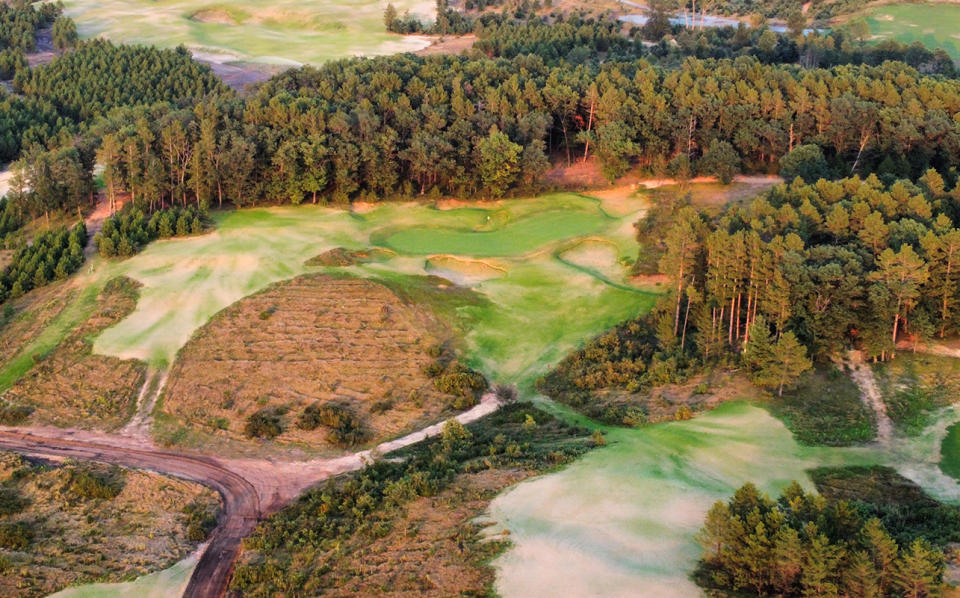
Sedge Valley, a Tom Doak-designed golf course being built Sand Valley in Wisconsin, is expected to open in 2024. (Golfweek)
If I knew I had a client who I knew was comfortable with that, I would do it. But I know enough to know that certain things are going to be a harder sell to one client than the next.
You know, we’re doing the par-68 course at Sand Valley (Sedge Valley, under construction in Wisconsin) right now. But we set out knowing that we’re going to do that. If I hadn’t set out knowing I was going to do that, that’s probably not the first thing you’re going to find because you’re programmed to find a good mix of holes and you’re always looking for a good par 5 where you can find it. So typically I’m going to find a couple, because I always try. But at that site, we had already decided this is what we’re going to do, so I’m not going to worry about that. And it’s actually a lot easier, and there was a lot more freedom.
I’ve always found that par 5s are the toughest holes to design and the toughest holes to work out the details on, because it really needs to work everywhere for everyone. When I worked for Pete Dye, he said to me once, “People criticize me for designing for good players, and I should worry more about the average player. At least with good players, after two shots you kinda know where they’re going to be at, but an average player after two shots could be anywhere. They could still be on the tee, hitting three.”
And I laughed because it was so true, and that’s the hard thing about designing a par 5. After two shots, you’ve got people 250 yards away with a 3-wood in their hands, and they want to be able to try to hit a shot and hold the green. And you’ve got people up there chipping at it, and everything in between. A short par 4 is easier. A par 3 is much easier. You kind of control where everybody is coming in from.
You mentioned Sedge Valley. How nice was the freedom there after being constrained in your work on the Lido (a reconstruction of a historic course on Long Island that was lost decades ago, with the new course set to open in 2023 at Sand Valley) with its historic demands? You were able to go across the street and do what you want again.
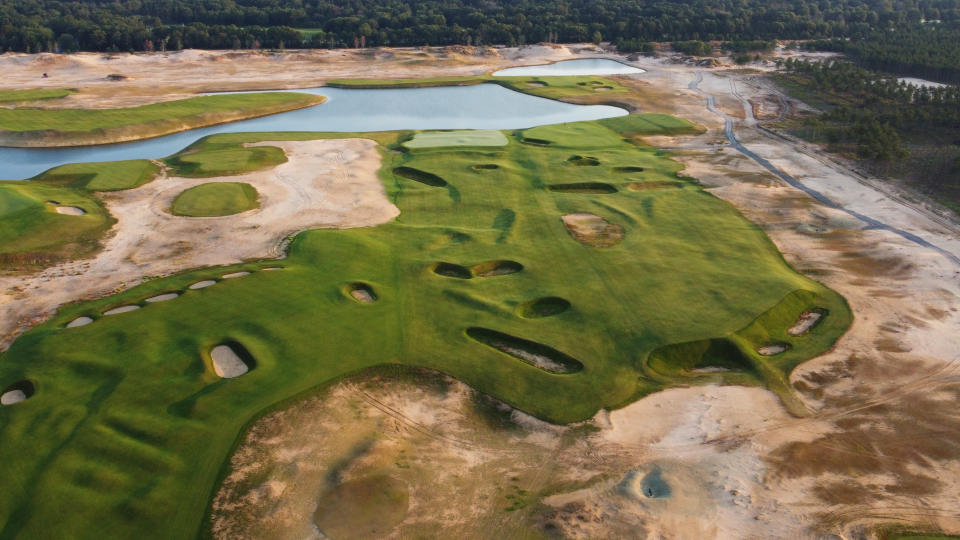
The Lido at Sand Valley in Wisconsin (Golfweek)
With the Lido, (Sand Valley co-developer) Michael (Keiser) wanted to use the word “restoration” on it, and I was a little nervous about that early on. But that’s what it felt like when we were in the middle of it, because all the computer modeling of it got us something pretty close to start with. Then it’s the same thing as a restoration.
We were looking at the old photos and we’re looking at what’s there, and instead of saying “Oh, they changed that,” it was “Oh, we didn’t get that quite right.” But it’s still the same process of working on each hole in detail and trying to see what else you’ve got in the photo that isn’t really out there.
But I don’t think of the Lido as my design at all. It’s an interesting project to do, but certainly more of my ego is tied up in the new one (Sedge Valley) across the street. That one is mine, and I have wanted to do a project like that for a long time. So it’s really exciting to get to do it. It’s kind of weird, too, because it’s a really big piece of land for a small golf course. You look at the space in between some of the holes and it’s like, “We probably could have got more in here if we had been trying.” But there’s a bunch of really good holes.
How important is it for this (new course at Cabot Highlands) to be different than what’s already here, complementary or completely unique?
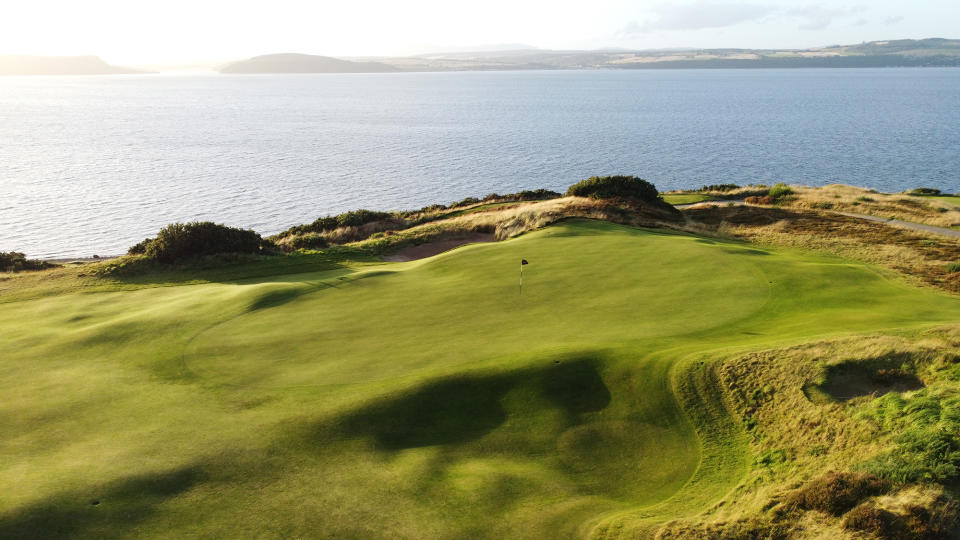
Gil Hanse and Mark Parsinen designed the original 18 at Castle Stuart in Scotland, now named Cabot Highlands. (Golfweek)
Clyde (Johnson, who works for Doak) and I were just talking about that, and I’ve talked with Ben (Cowan-Dewar) about it a little bit. People come to Scotland to play a variety of golf courses, and they’re all seaside and the links factor into a lot of them, but the featuring is very different from one of them to the next. I don’t think we have to be overly concerned at the beginning that we’re trying to make it really different than (the original course), as long as it feels like it fits in Scotland. Whether it’s a little more like this or a little less like this, I don’t think will make any difference.
We have talked through some interesting twists on concept, but I’ve got to make sure Ben is comfortable before I announce anything (said with a laugh).
What’s the sort of craziest thing you guys have dreamed up?
Employees work on the face of a revetted bunker on the New Course at St. Andrews in October. Such classically designed bunkers, famous in Scotland, require a lot of maintenance. (Jason Lusk/Golfweek)
Again, you go back to bunkers. Do we want 150 bunkers, or do we want none? I would do none somewhere, with the right client. And there are two ways of doing none. One is no open sand, and one is just no formal bunkers – you could still have sand scrapes here and there for visual effect. But if you’re doing that, you wouldn’t do it right up by the green because that would be too hard to maintain.
We’re not as budget-challenged around here as at, say, Brora or some of the other courses around here. But the revetted bunker standard (in which sod is stacked steeply on the face of a bunker) that everyone uses here is really expensive for a lot of the smaller courses. Whatever money they make for the year, they’re spending half of it rebuilding 15 bunkers every winter. Muirfield and St. Andrews are rebuilding 30 every winter, 30 or 40. It gives something for the crew to do in the winter, but it’s very labor-intensive. Everybody sort of looks at these revetted bunkers as the standard for over here, but it’s a hard standard to keep up with.
They certainly played around with it on this golf course (the original course at Castle Stuart), and there are some (revetted bunkers), but there are others that are more naturalized looking. They tried to keep it to a reasonable number (of revetted bunkers).
What’s it like to work on a site like this where it’s been smoothed out by years of farming and plowing? Does it free it up a little where you get to create your own internal contours and let your imagination go crazy?
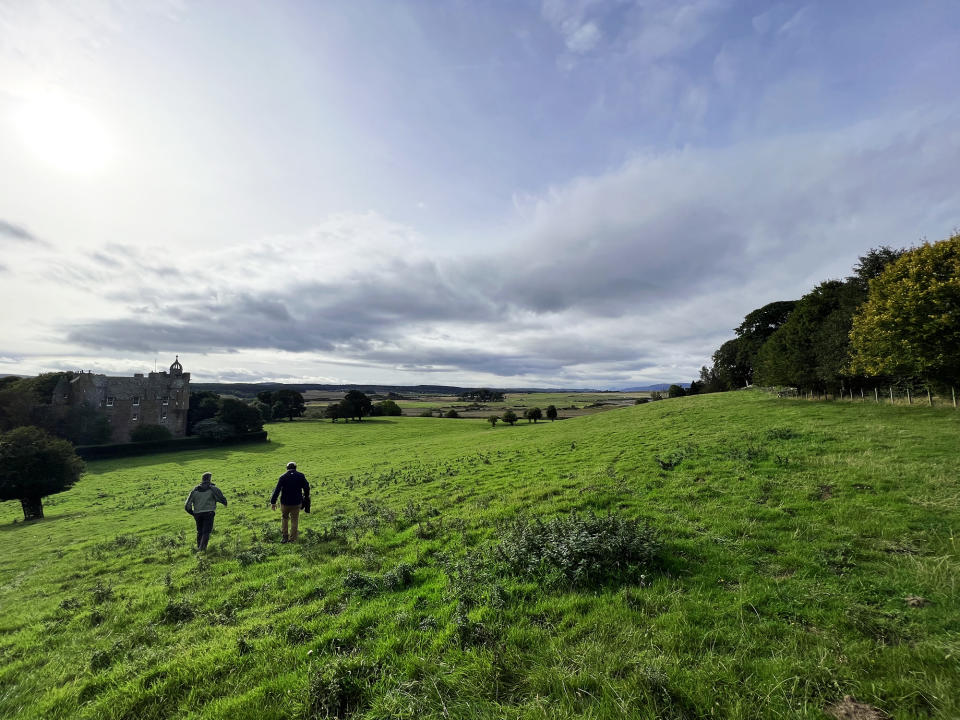
Tom Doak with Clyde Johnson at the site of a new course and 400-year-old castle at Castle Stuart/Cabot Highlands near Inverness, Scotland. (Jason Lusk/Golfweek)
That’s where you’ve got to have a good sense of what the character of Scottish links really is. The good thing about trying to do this in Scotland instead of in Florida is, if you’re ever not sure, you drive right over there (pointing out window), or drive up north, and go have a look at a few other courses.
You know, I think most architects, we do too much. The things that are cool about the contouring here (in Scotland) is that it’s small scale and it’s wrinkly, but there are large expanses of fairly flat stuff in with that. It doesn’t just keep going with jittery contours forever. Even the most complex golf courses have big areas of relatively flat areas.
The Old Course (at St. Andrews), you know, has half a dozen fairways that are pretty flat. That blends in pretty well with some of the other ones that are really up and down. Also, nothing ever gets too high.
You think about it, we’re working on something now that we’re trying to bring in some links contours so it’s almost like we’re going around and looking at things and sampling (other courses). Like, “We could do something like that little stretch somewhere else.” But it does show you how overdone we do stuff.
Like, the stuff we’ve picked up on (is that the old links courses are) much, much flatter when we made a plan of it. It was much flatter than I thought it was. If you think about it, when you’re playing a golf hole and standing on the ground, anything that’s over five feet or five and a half feet high, you can’t see beyond that. So all these little ups and downs on links courses generally are not up and down more than two or three feet.
[afflinkbutton text=”Book your trip to the Old Course at St. Andrews” link=”https://www.golfbreaks.com/en-us/vacations/st-andrews/st-andrews-links/old-course/?cid=999739949&utm_medium=referral&utm_source=golfweek&utm_campaign=scotland_best_courses_q3_22_gw”>
What is Ben saying? What are the conversations you’ve had, and is he saying just to be Tom Doak?
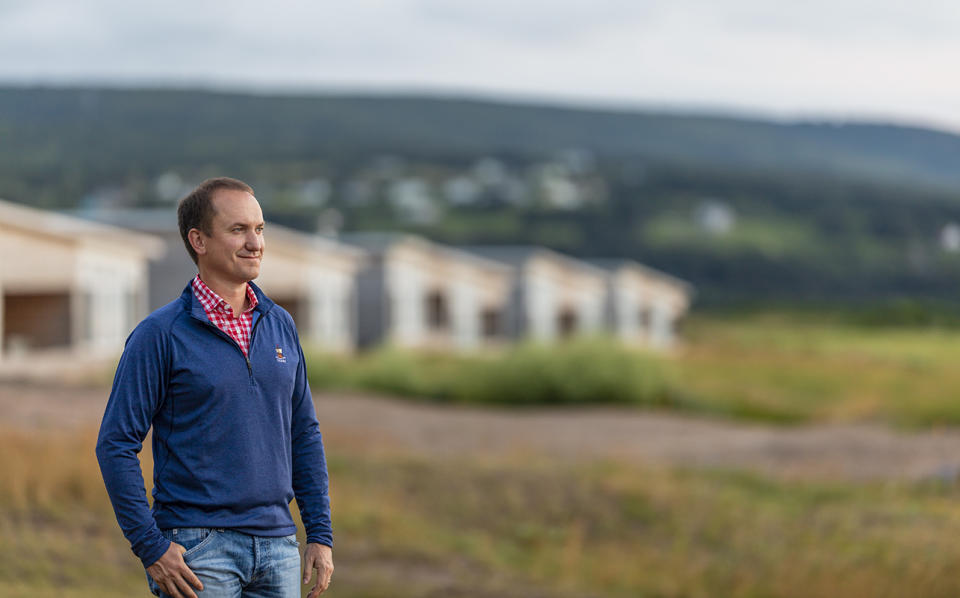
Ben Cowan-Dewar is the CEO and co-founder of Cabot, which has branched out from Canada to locations in the U.S., Caribbean and Scotland. (Courtesy of Cabot)
He’s going crazy today because I’ve been here three days and I haven’t given him a plan or feedback yet on what we’re thinking (said with a laugh). I had an email yesterday and I just haven’t had time to get back to him because we’re still grinding away on it. But I’m sure he’s like, “What are they going to do to me?”
Ben, more than most clients, he really has an eye for design. The danger of Ben from my perspective is that he does have that, and any project like this that he’s looking at getting involved with, he’s probably already got his own ideas of what would work out there. And he’s been nice enough to not jam all those on me right at the beginning and let me look at it with a fresh eye. Hopefully, I’ll say a bunch of things he likes the sounds of instead of feeling like he has to correct me (said with a laugh).
Every client is different, and you know, I’ve known Ben for a long time but we haven’t worked together before. So it’s going to take a little feeling out in the next year or two to understand how we work best together.
I learned early on that when you’re young, you think that what you want to hear from the client is, “Just turn me loose and let me do whatever.” But I found out early in my career that wasn’t really that great a long-term solution.
Because if you do that and build exactly what you want but the client may not understand it, when the typical golfer walks off the 18th hole and says he hates No. 5 – which means he double-bogeyed it – if the client wasn’t involved in the process at all then they don’t defend it. They also, much more than I do, have to be in the mode of the customer is always right, so you want to listen.
But if the client was involved with No. 5 and likes it, then he is going to dismiss the random negative comment about it the same way I will. And it’s only going to bother him if 10 groups in a row come in and say they don’t like No. 5. Otherwise, it’s just noise.
You look at Mike Keiser (founder of Bandon Dunes Golf Resort in Oregon and several other notable properties, including a partnership with Cowan-Dewar – and the father to the prementioned Michael Keiser of Sand Valley), who you know well, he doesn’t want his designers building anything much over 6,700 yards. He’s really tried to gear everything for the amateur golfer, and he doesn’t really care about the professionals or anything like that. So is there a way to challenge the best (recreational amateur) players at 6,700 yards?
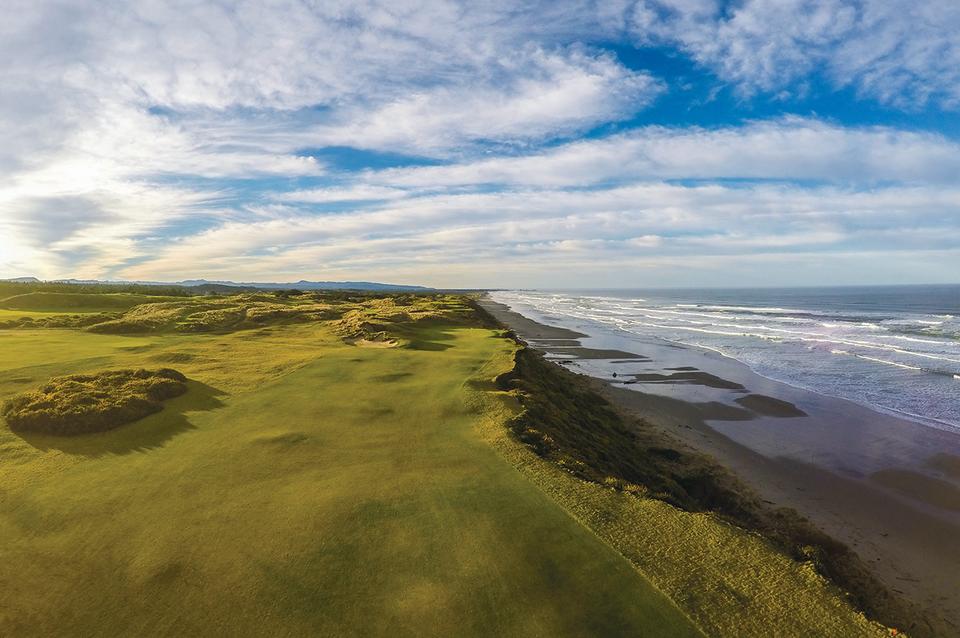
Pacific Dunes at Bandon Dunes Golf Resort in Oregon was designed by Tom Doak and is No. 2 on Golfweek’s Best list of modern courses in the U.S. (Courtesy of Bandon Dunes Golf Resort)
Not pros, and not really anyone under (the age of) 35 who played college golf. They hit it like pros. They just aren’t as consistent as pros. And those guys, every golf course is super short for them. You can still make it tricky for them, and you can make some holes where they’re going to have a challenging shot, but at the end of the day when you add up the numbers, they’re going to shoot 67, 68 regularly and they can go lower than that if they have a good day. If you try to defend for them, it’s going to be way too hard for everybody else. It’s (only a problem for us) if our clients tell us they’re trying to get that full spectrum of player.
You know, I worked for Pete Dye at the start of my career, and everybody says to me that, “your golf courses are so different than Pete’s.” And I just say no, I just don’t have to worry about the players that Pete was worried about. Every project we worked on was like the Stadium Course at PGA West, and what are we going to do to make it challenging for Greg Norman?
When I got out on my own and I was building my first course in Traverse City (Michigan), if the client had said, “What if we have a tournament here?” I could just laugh at him and say, first of all, if you don’t have $5 million burning a hole in your pocket, then they’re not coming. And second, those guys (the pros) are not the guys who pay to play golf. Aren’t we building this to break even or do better? And for people to have fun on? And if you are, don’t worry about the Tour pros. That’s a whole different thing.
That’s kind of where Mike Keiser’s attitude has been from the beginning, and I think that’s mostly where Ben’s attitude is here.
Mark (Parsinen, founder and co-designer of the original course at Castle Stuart) was much more interested in having a Scottish Open here and figuring out something that was tough enough that even if the winning score was pretty low, that those guys would have felt like they were challenged on the golf course. And I think he did a great job of that.
When I started Pacific Dunes (the second course built at Bandon Dunes Golf Resort in Oregon), Bandon Dunes (the first course at the resort) was 7,300 yards long, and I was building Pacific at like 6,600 and everybody was like, don’t we need more tees, shouldn’t we go farther back? Even Mike, because he had other people whispering in his ear about it all the time. And I just said, if you’re going to have the U.S. Amateur, you’ve already got that course (Bandon Dunes). You don’t need to do that again. This is a resort.
I haven’t really talked to Ben about this (new course at Castle Stuart), but we don’t have to do that (pro-style course) again. If there’s going to be a tournament held here, it’s going to be on this course (the original at Castle Stuart), and my ego is fine with that.
But don’t you think Pacific Dunes (Golfweek’s Best No. 2 modern course in the U.S.) would hold up to a U.S. Junior or a U.S. Amateur?
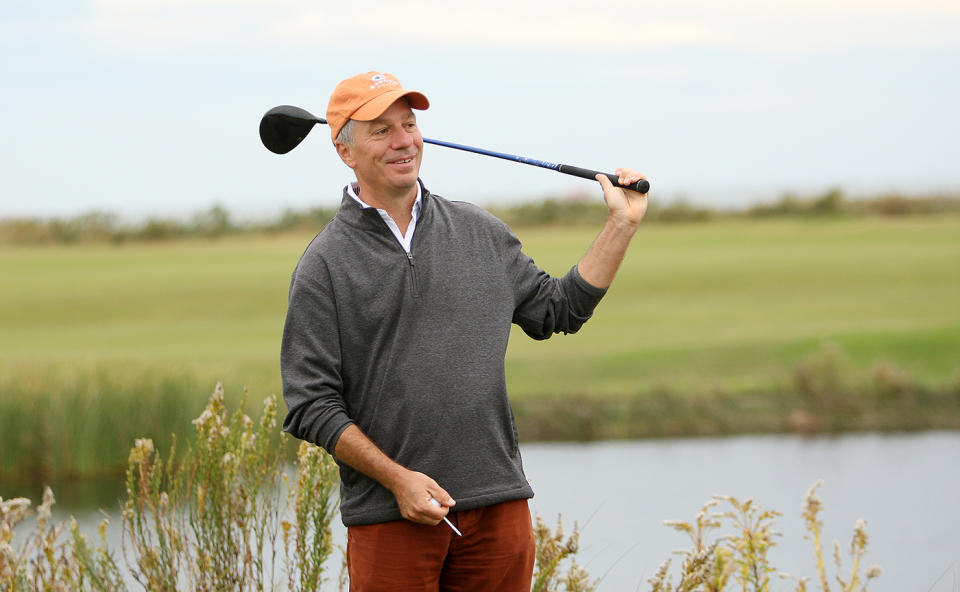
Tom Doak, pictured at the Ocean Course at Kiawah Island Golf Resort in South Carolina, said he was never a great golfer and that if he can play a course, then the customers of a resort should be able to, also. (Golfweek files)
Yeah, and the funny thing about Pacific Dunes to me is when we built it everyone was like, it seems too easy to be a really great golf course. And now Pacific and Bandon Trails are the two hardest courses (at Bandon Dunes Golf Resort) for the average player. And that’s how much the perception of what designers should be doing has changed in the last 20 years.
At that point, we were still in the mode of having to build something that challenged a scratch player. And now that’s not really the point anymore.
I still like building stuff that’s challenging to people, and I don’t want to just pander to making it super wide and have everybody shoot their lowest career round. It would be hard to have worked with Pete Dye and feel like that’s what you were after (said with a laugh).
You know, a lot of architects are really good players. The worst part of that, their buddies are too. So all the feedback they get is, “you’ve got to make that harder” or “you could make that green even narrower, and just turn it a little more.” There are a lot of young architects, that is exactly what they do not need to hear. They’re already good players, and they’re having a hard time visualizing how the average person is going to enjoy the thing.
I was never that great (a player), and I’m on the downward slope of my golf career right now. If it’s fun for me, it will be fun for average players. So I’ve never had to worry about that too much. I can make something that looks pretty challenging to me and that I know will challenge a really good player some way or another, but the average person is still going to have a way to play it. I don’t have to think about that as a separate topic, which a lot of architects do.
Do you think about design any differently because we’re here in Scotland, versus if this site was in Wisconsin or Oregon or somewhere like that, given that you’re surrounded by so much history?
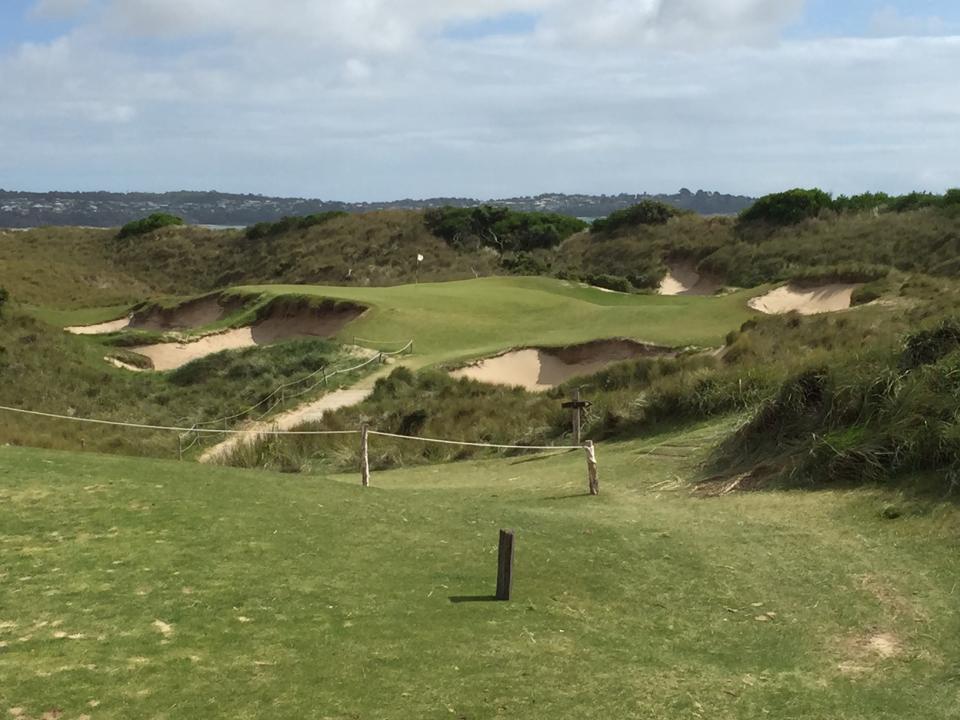
The Tom Doak-designed Barnbougle Dunes in Tasmania (Golfweek)
Well, it’s not just here. You have to think about conditions, and that this is a windy place and if you put a bunker right up in the front of the green … it’s the downwind situation that’s the hardest. The ground is firm, and you have to give everybody a way to play some shot. Even the best players in the world can’t just make the ball stop on a dime downwind on a really firm golf course. And you know you’re going to get that here.
I’ve been lucky that I’ve been able to work in a few other places around the world where we get that too, like at Bandon Dunes and Barnbougle (Dunes in Tasmania) and pretty much everything I’ve done in New Zealand. They have those kinds of conditions. So that’s not so new for me as it would be for some people.
I still think that we as designers have a hard time visualizing people hitting the ball along the ground the way they do over here and really designing an approach for landing the ball 20 or 30 yards short of the green and feeding off something to get it in there. We all talk about it like we do that, but I don’t see many modern courses where you would want to hit those shots. The more we can get that here, the more it will feel like a real Scottish golf course. …
Done right, the Holy Grail of golf course design is to come up with something that’s harder for an elite player than it is for an average player. It is possible.
[afflinkbutton text=”Book your trip to Cabot Highlands today” link=”https://www.golfbreaks.com/en-us/vacations/highlands/castle-stuart-golf-links/?cid=999739949&utm_medium=referral&utm_source=golfweek&utm_campaign=scotland_best_courses_q3_22_gw”>
